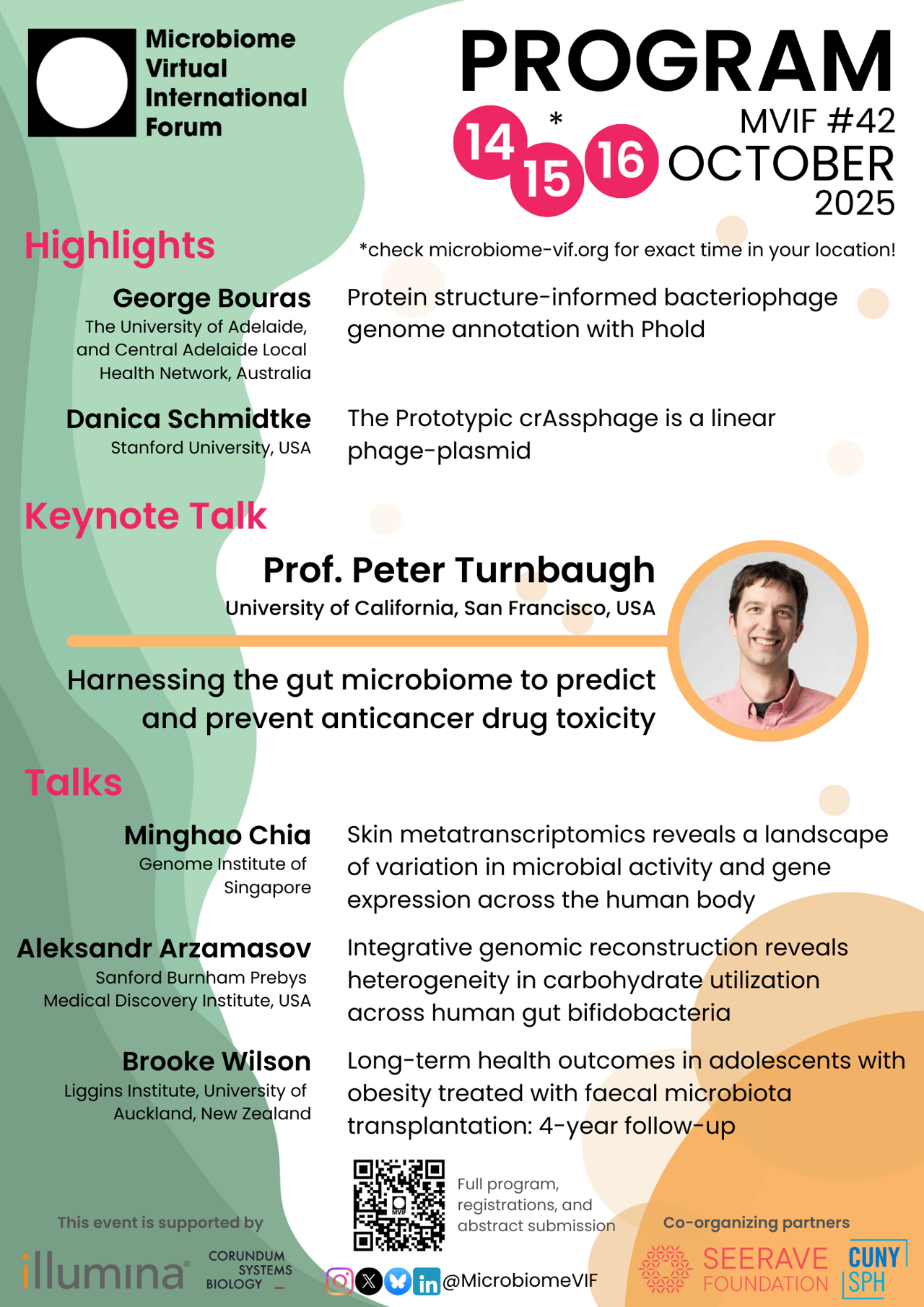Keynote talk
Harnessing the gut microbiome to predict and prevent anticancer drug toxicity
By Prof. Peter J. Turnbaugh, University of California, San Francisco
Although the importance of human genetic polymorphisms and drug-drug interactions in precision medicine is increasingly understood, the role of specific genotypic variants and products elaborated by our “second genome” (the microbiome) has been largely overlooked. In this presentation I will describe a microbiome-informed approach to pharmacology, working to elucidate the direct and indirect mechanisms through which the human microbiome shapes the efficacy and toxicity of small molecule and biologic therapies. I will focus on two recent studies that couple longitudinal sampling of the human gut microbiome during colorectal cancer (CRC) treatment with downstream experiments in cell culture and mouse models. We reveal two distinct mechanisms through which drug-induced shifts in the gut microbiota protect from drug toxicity: drug inactivation and the biosynthesis of chemoprotective metabolites. Furthermore, we demonstrate a proof-of-concept for the use of microbiome profiling and machine learning to predict drug toxicities across independent cohorts. Taken together, these results provide a foundation for future human intervention studies, more in-depth mechanistic dissection in preclinical models, and extension to other cancer treatments.
Highlights
Protein Structure-Informed Bacteriophage Genome Annotation with Phold
By George Bouras, The University of Adelaide
Bacteriophage (phage) genome annotation is essential for understanding their functional potential and suitability for use as therapeutic agents. Here we introduce Phold, an annotation framework utilising protein structural information that combines the ProstT5 protein language model and structural alignment tool Foldseek. Phold assigns annotations using a database of over 1.36 million predicted phage protein structures with high quality functional labels. Benchmarking reveals that Phold outperforms existing sequence-based homology approaches in functional annotation sensitivity whilst maintaining speed, consistency and scalability. Applying Phold to diverse cultured and metagenomic phage genomes shows it consistently annotates over 50% of genes on an average phage and 40% on an average archaeal virus. Comparisons of phage protein structures to other protein structures across the tree of life reveals that phage proteins commonly have structural homology to proteins shared across the tree of life, particularly those that have nucleic acid metabolism and enzymatic functions. Phold is available as free and open-source software at https://github.com/gbouras13/phold.
The Prototypic crAssphage is a linear phage-plasmid
By D_anica Schmidtke_, Stanford University
The prototypic crAssphage (Carjivirus communis) is an abundant, prevalent, and persistent human gut bacteriophage, yet it remains uncultured and its lifestyle uncharacterized. C. communis does not readily plaque, suggesting a largely non-lytic lifestyle. Here, we find that C. communis is a linear phage-plasmid that stably persists extrachromosomally within its host. Plasmid and phage-related genes are transcribed, and multiple putative replication origins may initiate replication for multiple lifestyles and genome conformations, including both circular and linear formations. Leveraging these findings, we use a plaque-free culturing approach to measure C. communis replication on prevalent gut bacteria, notably Phocaeicola vulgatus, P. dorei, and Bacteroides stercoris, revealing a broad host range. C. communis persists without causing major cell lysis events or integrating into host chromosomes. Taken together, C. communis’ ability to switch between phage and plasmid lifestyles within a wide range of hosts may contribute to its widespread presence in human gut microbiomes.
Talks
Skin metatranscriptomics reveals a landscape of variation in microbial activity and gene expression across the human body
By Minghao Chia, Genome Institute of Singapore
Metatranscriptomics methods for the skin are hampered by low microbial biomass, contamination with host cells, and low RNA stability. We develop a robust, clinically tractable skin metatranscriptomics workflow that provides high technical reproducibility of profiles, uniform coverage across gene bodies, and strong enrichment of microbial mRNAs. Paired application of this protocol with metagenomics to five skin sites in a cohort of 27 healthy adults identifies a notable divergence between transcriptomic and genomic abundances. Specifically, Staphylococcus species and the fungi Malassezia had an outsized contribution to metatranscriptomes at most sites, despite their modest representation in metagenomes. Species-level analysis shows signatures of microbial adaptation to their niches. Gene-level analysis identifies diverse antimicrobial genes transcribed by skin commensals in situ, including several uncharacterized bacteriocins. Correlation of microbial gene expression with organismal abundances uncovers >20 genes that putatively mediate interactions between microbes. This work highlights how skin metatranscriptomics identifies active species and microbial functions in situ.
Integrative genomic reconstruction reveals heterogeneity in carbohydrate utilization across human gut bifidobacteria
By Aleksandr Arzamasov, Sanford Burnham Prebys Medical Discovery Institute
Bifidobacteria are beneficial saccharolytic microbes that are widely used as probiotics or in synbiotic formulations, yet individual responses to supplementation can vary with strain type, microbiota composition, diet and lifestyle, underscoring the need for strain-level insights into glycan metabolism. Here we reconstructed 68 pathways for the utilization of mono-, di-, oligo- and polysaccharides by analysing the distribution of 589 curated metabolic gene functions (catabolic enzymes, transporters and transcriptional regulators) across 3,083 non-redundant Bifidobacterium genomes of human origin. Thirty-eight predicted phenotypes were validated in vitro for 30 geographically diverse strains, supporting genomics-based predictions. Our analysis uncovered extensive inter- and intraspecies functional heterogeneity, including a distinct clade within Bifidobacterium longum that metabolizes α-glucans and Bangladeshi isolates carrying unique gene clusters for xyloglucan and human milk oligosaccharide utilization. This large-scale genomic compendium advances our understanding of bifidobacterial carbohydrate metabolism and can inform the rational design of probiotic and synbiotic formulations tailored to strain-specific nutrient preferences.
Long-term health outcomes in adolescents with obesity treated with faecal microbiota transplantation: 4-year follow-up
By Brooke Wilson, Western University
Faecal microbiota transplantation (FMT) has been explored as a potential treatment for obesity, but its long-term effects on metabolic health remain unclear. Here, we report 4-year follow-up findings from a double-blind, randomised, placebo-controlled trial assessing FMT in adolescents with obesity (ACTRN12615001351505, Australian New Zealand Clinical Trials Registry). This unblinded follow-up study evaluated 63% (55/87) of the original participants (27 FMT, 28 placebo). There was no difference in BMI between the two groups, after adjusting for sex, age, diet, and physical activity (−3.6 kg/m2, p = 0.095). However, FMT recipients showed clinical improvements in body composition and metabolic health compared to the placebo group. Specifically, FMT recipients had smaller waist circumference (−10.0 cm, p = 0.026), total body fat (−4.8%, p = 0.024), metabolic syndrome severity score (−0.58, p = 0.003), and systemic inflammation (−68% hs-CRP, p = 0.002) and higher levels of HDL cholesterol (0.16 mmol/L, p = 0.037). No group differences were observed in glucose markers, or other lipid parameters. Shotgun metagenomic sequencing revealed sustained long-term alterations in gut microbiome richness, composition and functional capacity, with persistence of donor-derived bacterial and bacteriophage strains. These findings highlight the potential relevance of FMT as a microbiome-augmenting intervention for obesity management and metabolic health, warranting further investigation.

